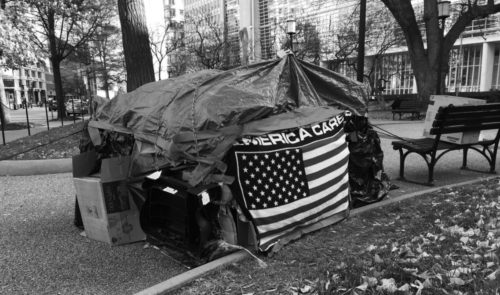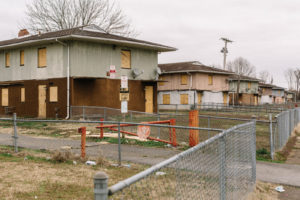Could This Be the Humane Housing Policy We’ve Been Waiting For?
Housing First provides homes to the homeless, without tying eligibility to completion of programs for substance abuse. Jeffrey / Flickr
Jeffrey / Flickr
For decades, U.S. housing policy has neglected homeless people with substance abuse disorders by relying on a treatment-first “linear model” barring them from subsidized or government-supported housing. But a new plan is showing promising results in servicing this overlooked community, and it already has the backing of both Democrats and Republicans.
The Housing First model is radically straightforward: provide homes to the homeless. Unlike other approaches to ending homelessness, the model neither predicates itself on sobriety nor on the completion of services or programs—a sharp departure from the linear model, which requires individuals to complete treatment for substance abuse before granting eligibility for permanent housing.
Housing First has garnered attention from federal officials since 2014, but many have been surprised that Ben Carson, the conservative secretary of the Department of Housing and Urban Development, has upheld its standards under the Trump administration. HUD’s Housing First requirements ensure that homeless assistance service providers comply before receiving a portion of the record-breaking $2 billion in federal funding allotted to such programs earlier this month.
Perhaps unsurprisingly, the homeless population is disproportionately affected by drug abuse. According to the 2016 National Survey on Drug Use and Health, 2.7 percent of Americans age 12 and older met the criteria for illicit drug use disorder, and 10.6 percent of survey participants reported drug use within the past 30 days. The National Coalition for the Homeless reports even higher rates of drug abuse—26 percent—among homeless individuals. Yet another study, from the American Public Health Association, finds that as much as two-thirds of the homeless population have a lifetime history of alcohol and drug abuse.
These exorbitantly high rates raise pressing questions about cause and effect. The National Coalition for the Homeless is quick to dispel the myth that homelessness invariably begins with drug abuse. Frequently, those who turn to drugs are coping with stresses related to existing living and housing situations. According to a 2007 study published by Visions Mental Health and Addiction Journal, some homeless people view drug and alcohol use as a vital component to social acceptance within the homeless community. And because many homeless people do not maintain social networks of their own, they may view integration into this community as necessary to their survival.
Still, drug abuse can help cause an individual to become homeless. The National Coalition for the Homeless notes that “for people who are already struggling to pay their bills, the onset or exacerbation of an addiction may cause them to lose their housing.” Those with substance abuse disorders may have difficulty holding a job and making rent or housing payments. Additionally, drug abusers often forfeit a vital safety net by alienating themselves from friends and family. The Visions Mental Health and Addiction Journal found that substance abuse issues were a major factor for as much as two-thirds of the homeless population.
The federal adoption of Housing First is not the first implementation of this policy. Many cities have adopted the model as a matter of necessity. In a 2008 survey of the United States Conference of Mayors, 68 percent of its members reported substance abuse as the most prevalent cause of urban homelessness among single individuals. Another 12 percent called it one of the top three causes of homelessness among families. In 2016, the organization reported that the best way to tackle homelessness in its communities was through “more mainstream housing assistance and/or affordable housing,” as well as “better coordination with mental health and substance abuse services.”
Housing First counts Utah among its greatest successes. In 2015, NPR reported that the state’s chronically homeless population fell by an astounding 91 percent over 10 years. For the fiscally conservative-minded, not only was the program effective, it yielded significant savings for taxpayers. Utah’s Homeless Task Force reported that the average cost of care per chronically homeless person in Utah was $19,208. After the adoption of Housing First, the cost of housing and assigned caseworkers was less than half that ($7,800).
Since 2016, however, the state’s homeless population has doubled. “State officials cite a combination of factors for the backward slide, including rising land and housing costs in booming U.S. cities, stagnant wage growth and a nationwide opioid epidemic,” reports Real Change News. Still, proponents of Housing First remain hopeful. “The only thing I’ve ever seen that really worked in terms of reducing the number of people on the street was the Housing First policy,” Glenn Bailey, who directs the Crossroads Urban Center in Salt Lake City, told Real Change News.
While Housing First is not impervious to market factors or demographic changes, the model nonetheless creates new opportunities for a population long underserved. And as federal and municipal governments move away from policies that restrict housing access to drug abusers, they inch ever closer to ending the scourge of homelessness. In the process, they may even find reductions in substance abuse among those with a safe and affordable home of their own.
Your support matters…Independent journalism is under threat and overshadowed by heavily funded mainstream media.
You can help level the playing field. Become a member.
Your tax-deductible contribution keeps us digging beneath the headlines to give you thought-provoking, investigative reporting and analysis that unearths what's really happening- without compromise.
Give today to support our courageous, independent journalists.





You need to be a supporter to comment.
There are currently no responses to this article.
Be the first to respond.